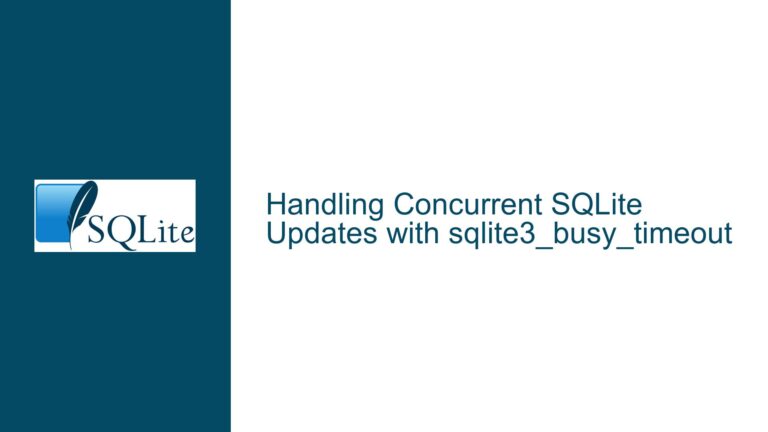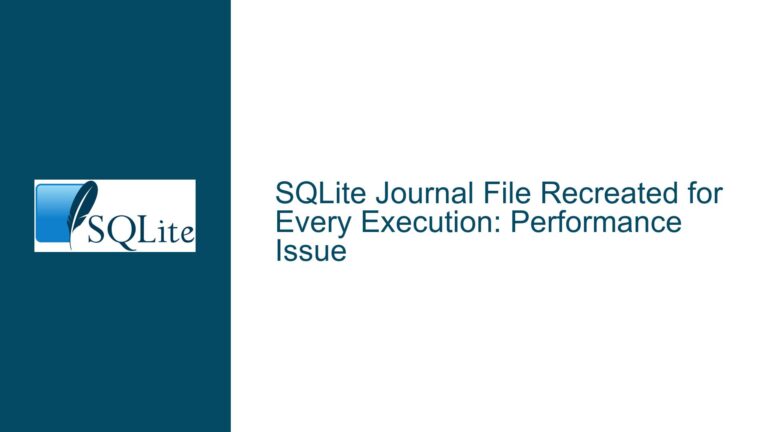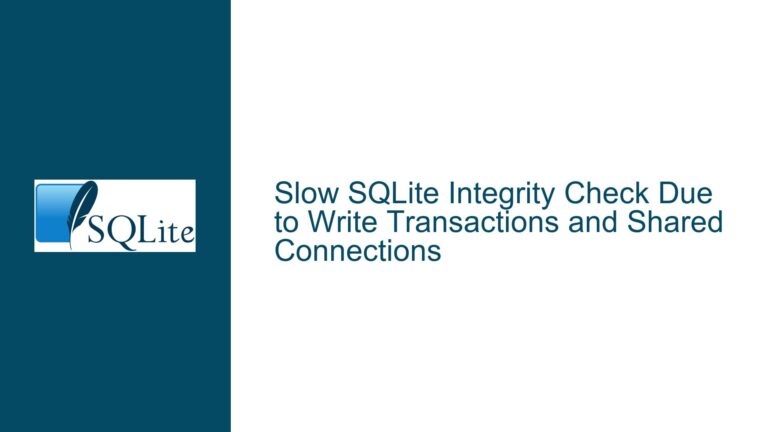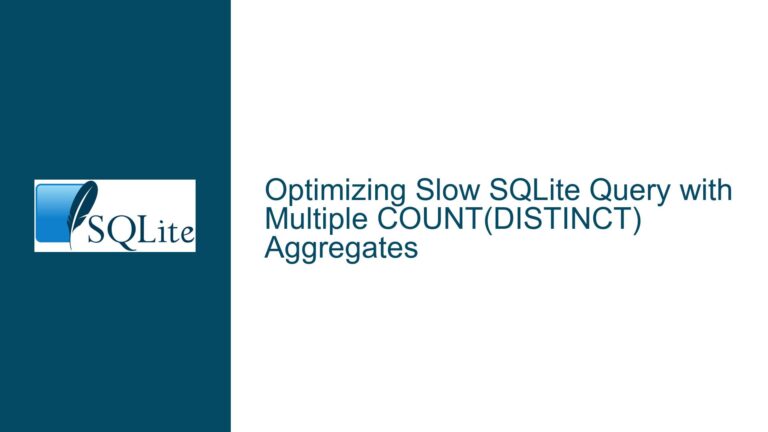Enhancing CTE Join Performance with Indexed Common Table Expressions in SQLite
Issue Overview: Inefficient Joins on CTE-Derived Tables Due to Lack of Index Support
Common Table Expressions (CTEs) in SQLite, defined via the WITH clause, are powerful tools for organizing complex queries into modular, readable subqueries. However, when these CTEs are materialized (i.e., cached in memory or temporary storage for reuse), they lack explicit index support. This becomes problematic when joining large CTE-derived tables in the main query, as SQLite’s query planner resorts to full table scans instead of indexed lookups.
In the provided use case, the user reads data from text files via a virtual table (VirtualLookupTextTable) within a CTE. The CTE processes this data (e.g., extracting timestamps via substr() and filtering with instr()), materializing a result set (LookupTable). The main query then performs a LEFT OUTER JOIN between another virtual table (VirtualMainTextTable) and LookupTable, using timestamp ranges. Without an index on LookupTable.TimeStamp, SQLite must scan all 29,000 rows of the CTE for each row in VirtualMainTextTable, leading to a combinatorial explosion of operations (evidenced by the 544-second execution time).
The query plan confirms this inefficiency:
3 0 0 MATERIALIZE ViewStateMachineState
6 3 0 SCAN AllStateMachineText VIRTUAL TABLE INDEX 0:
25 0 0 SCAN AllPLCcommLog VIRTUAL TABLE INDEX 0:
The SCAN operations indicate sequential reads, whereas an indexed SEARCH would drastically reduce I/O. The user’s proposal to extend the WITH clause syntax to declare indexes on CTE-derived tables aims to resolve this. However, SQLite currently lacks native support for indexing CTEs, necessitating workarounds or deeper optimizations.
Possible Causes: Why CTE Joins Suffer from Full Scans and Poor Performance
1. Absence of Index Metadata on Materialized CTEs
When a CTE is materialized using AS MATERIALIZED, SQLite stores its result set in an ephemeral table-like structure. However, unlike temporary or persistent tables, materialized CTEs do not persist index definitions. Even if the underlying SELECT statement includes indexed columns, the materialized result set discards this metadata. Consequently, the query planner cannot leverage indexes for joins or filters on the CTE.
2. Virtual Table Limitations
The user’s data source is a virtual table (VirtualLookupTextTable) that reads from text files. Virtual tables, especially those backed by custom extensions, often lack native indexing capabilities. While SQLite’s built-in virtual tables (e.g., FTS3) support indexing, custom virtual tables require explicit implementation of the xBestIndex method to utilize indexes. If the virtual table extension used here does not implement this method, SQLite cannot push index-related optimizations to the data retrieval layer, forcing full scans during CTE materialization.
3. Automatic Indexing Heuristics Not Triggered
SQLite can create automatic indexes for temporary tables when it deems them beneficial. However, this heuristic does not apply to materialized CTEs. The optimizer treats CTEs as static datasets, prioritizing scan operations even if the join columns are candidates for indexing. Additionally, the user’s join condition contains an OR clause:
on M.ToTimeStamp > M.FromTimeStamp
and L.TimeStamp > M.FromTimeStamp
and L.TimeStamp <= M.ToTimeStamp
or L.TimeStamp == M.ToTimeStamp
This complex predicate complicates the use of range-based indexes, further discouraging automatic index creation.
4. Temporary Table Overhead Avoidance
The user explicitly avoids using temporary tables with explicit indexes due to concerns about database bloat and portability. While creating a temporary table with an index would resolve the performance issue, it introduces storage overhead and complicates the database schema. The desire to keep the query self-contained (without relying on transient database objects) is valid but clashes with SQLite’s current optimization framework.
Troubleshooting Steps, Solutions & Fixes: Optimizing CTE Joins Without Native Index Support
1. Leverage Automatic Indexes on Temporary Tables
If portability and storage overhead are negotiable, materialize the CTE into a temporary table with explicit indexes. This approach sacrifices some elegance for performance:
CREATE TEMP TABLE TempLookupTable (
TimeStamp TEXT PRIMARY KEY,
LookupContent TEXT
);
INSERT INTO TempLookupTable
SELECT substr(Content,1,24), trim(substr(Content,26,40))
FROM VirtualLookupTextTable
WHERE instr(Content,'keyword');
SELECT FromTimeStamp, ToTimeStamp, M.Content, L.Content
FROM VirtualMainTextTable M
LEFT JOIN TempLookupTable L ON ...;
Pros:
- Full control over indexing.
- Query planner recognizes indexes for efficient joins.
Cons:
- Introduces temporary table management.
- Requires schema modifications, reducing query self-containment.
2. Restructure the Query to Encourage Index Usage on Virtual Tables
If the virtual table extension supports indexing (via xBestIndex), pre-filter and index the data at the virtual table level. For example, push the instr(Content,'keyword') filter into the virtual table’s query logic, reducing the rows materialized in the CTE. This requires modifying the virtual table implementation but avoids changes to the SQL schema.
3. Use Subquery Factoring with Index Hints
While SQLite does not support CTE indexing, rewriting the CTE as a subquery with CROSS JOIN or JOIN hints can influence the optimizer’s behavior. For instance:
SELECT ...
FROM VirtualMainTextTable M
LEFT JOIN (
SELECT *, rowid AS __rowid
FROM (
SELECT substr(Content,1,24) AS TimeStamp,
trim(substr(Content,26,40)) AS LookupContent
FROM VirtualLookupTextTable
WHERE instr(Content,'keyword')
)
) L ON ...;
Adding rowid AS __rowid tricks SQLite into treating the subquery as an auto-indexed entity in some scenarios. Experiment with NOT MATERIALIZED CTEs to prevent premature materialization:
WITH LookupTable AS NOT MATERIALIZED (...)
This keeps the CTE inline, allowing the optimizer to integrate its logic into the main query plan, potentially utilizing indexes from underlying tables.
4. Proposed Syntax Extension for CTE Indexes
The discussion proposes extending CTE definitions with index declarations, akin to CREATE TABLE:
WITH LookupTable(
TimeStamp,
LookupContent,
PRIMARY KEY( TimeStamp )
) AS MATERIALIZED (...)
Implementation Challenges:
- SQLite’s parser would need to recognize index definitions within CTE declarations.
- The optimizer would have to associate these indexes with the materialized result set.
- Ephemeral index storage must align with the CTE’s lifecycle (indexes discarded after statement execution).
Workaround via SQLite’s Extension API:
Develop a custom extension that intercepts CTE materialization, creating temporary indexes on-the-fly. This bypasses syntax limitations but requires C-level programming.
5. Query Plan Analysis and Manual Optimization
Using EXPLAIN QUERY PLAN to diagnose bottlenecks:
EXPLAIN QUERY PLAN
WITH LookupTable AS (...)
SELECT ...;
Focus on eliminating SCAN operations on CTEs. If a SCAN is unavoidable, precompute join keys in the CTE to minimize comparisons:
WITH LookupTable AS (
SELECT
substr(Content,1,24) AS TimeStamp,
trim(substr(Content,26,40)) AS LookupContent,
-- Precompute range boundaries for join optimization
substr(Content,1,24) AS FromTimeStamp,
substr(Content,1,24) AS ToTimeStamp
FROM VirtualLookupTextTable
WHERE instr(Content,'keyword')
)
SELECT ...
FROM VirtualMainTextTable M
JOIN LookupTable L
ON M.ToTimeStamp BETWEEN L.FromTimeStamp AND L.ToTimeStamp;
6. Version-Specific Optimizations
Upgrade to SQLite 3.37.0+ for enhanced materialization heuristics. The MATERIALIZED/NOT MATERIALIZED hints (introduced in 3.35.0) allow finer control over CTE processing. For instance, NOT MATERIALIZED might enable index propagation from underlying virtual tables if they support indexing.
Final Recommendation:
Given the constraints, the optimal short-term solution is a temporary table with explicit indexes. For long-term scalability, advocate for a syntax extension via SQLite’s public channels or develop a custom extension to simulate CTE indexing. Meanwhile, refactor the query to exploit existing virtual table indexes and avoid OR conditions in joins.






